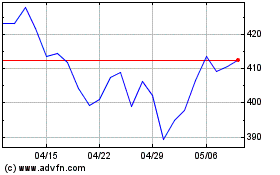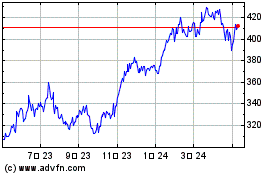Cloud-Computing Business Lifts Oracle's Profit -- Update
2017年6月22日 - 7:00AM
Dow Jones News
By Jay Greene
Oracle Corp. co-founder and executive chairman Larry Ellison
predicted three months ago the company's cloud-infrastructure
business would "soon" grow faster than its other web-based,
on-demand applications and services.
He didn't say then when soon would be. But it wasn't three
months.
On Wednesday, Oracle reported fourth-quarter results that topped
analysts' expectations, sending its stock soaring in after-market
trading. The company also changed the way it reports its
cloud-computing business.
Oracle is mixing its nascent infrastructure-as-a-service
business, where it provides computing resources and storage on
demand, with its more tenured business of selling access to
app-management and data analytics tools, called
platform-as-a-service.
In its fiscal fourth quarter, Oracle posted solid results in its
cloud-infrastructure business, where it competes against leaders
Amazon.com Inc., Microsoft Corp. and Alphabet Inc.'s Google.
Revenue from the business rose 23% to $208 million.
The Redwood City, Calif., company's platform-as-a-service
business, combined with its other cloud business that sells access
to applications -- known as software-as-a-service -- saw revenue
climb 67% to $1.15 billion for the quarter ended May 31.
Going forward, it isn't clear whether Oracle will continue to
break out its progress in the cloud-infrastructure market. On a
call with analysts, co-Chief Executive Safra Catz said Oracle
combined its platform and infrastructure cloud businesses because
"synergies and cross-selling between these two businesses is very
high."
Over all, Oracle earned a profit of $3.23 billion, or 76 a
share, in its fiscal fourth quarter, up from $2.81 billion, or 66
cents a share, a year earlier. The company said adjusted per-share
earnings, which commonly exclude stock-based compensation and other
items, were 89 cents.
Revenue rose 2.8% to $10.89 billion. Excluding the impact of a
strong U.S. dollar, revenue would have grown 4%, the company
said.
According to estimates gathered by S&P Global Market
Intelligence, analysts expected Oracle to earn 78 cents a share on
an adjusted basis, on revenue of $10.45 billion. Shares jumped 9.5%
to $50.18 in recent after-hours trading.
Mr. Ellison has made building the cloud-infrastructure business
one of Oracle's key missions, saying last summer "Amazon's lead is
over" after introducing Oracle's latest technology for the
market.
Amazon, though, continues to pull away. Its Amazon Web Services
unit, whose net sales are largely comprised of its
cloud-infrastructure business, grew 43% in the most recent quarter
to $3.66 billion.
To keep pace with rivals in the cloud-infrastructure market,
Oracle will need to meaningfully expand its capital spending and
operating expenses, Stifel Nicolaus & Co. analyst Brad Reback
recently wrote in a report.
Last year alone, Amazon, Microsoft and Google spent a combined
$31.54 billion in 2016 on capital expenditures and leases, much of
that on data centers to deliver cloud-infrastructure services.
Oracle spent $2.02 billion on capital expenditures, up from
$1.19 billion a year earlier. That, in part, led to operating
margins of 34%, compared with 43% in the previous fiscal year. The
company has said it doesn't believe it needs to spend as much as
rivals to catch up, arguing its technology is superior.
Mr. Reback, though, believes that the company will invest more
in data centers to compete in the cloud-infrastructure market.
"They will need to continue to spend $2 billion or higher a
year," Mr. Reback said in an interview.
Growth in Oracle's entire cloud business is outpacing the
decline in its legacy business of selling licenses to software
customers run on their own servers. The cloud business grew $502
million year-over-year while Oracle's new software-license revenue
fell $140 million. It is the fourth-consecutive quarter in which
Oracle's cloud-revenue gains outpaced declines in its legacy
software business.
Over all, revenue from new software licenses fell 5% to $2.63
billion.
The biggest piece of Oracle's software business remains its
massive software-license updates and product-support operations.
That segment generated $4.9 billion in revenue, a 2% gain from a
year earlier.
Write to Jay Greene at Jay.Greene@wsj.com
(END) Dow Jones Newswires
June 21, 2017 17:45 ET (21:45 GMT)
Copyright (c) 2017 Dow Jones & Company, Inc.
Microsoft (NASDAQ:MSFT)
過去 株価チャート
から 3 2024 まで 4 2024

Microsoft (NASDAQ:MSFT)
過去 株価チャート
から 4 2023 まで 4 2024
